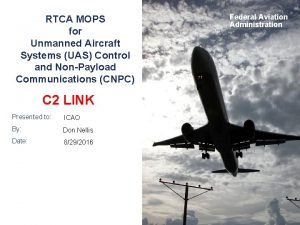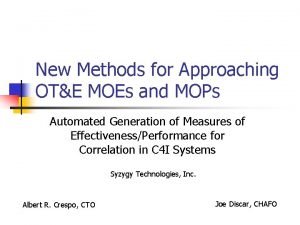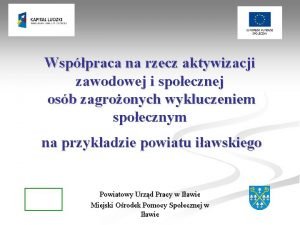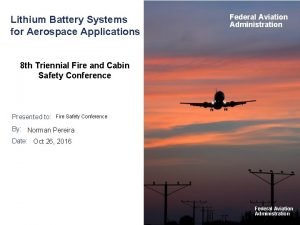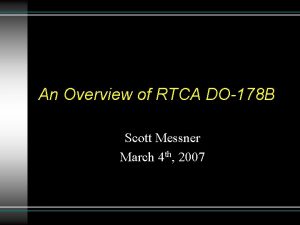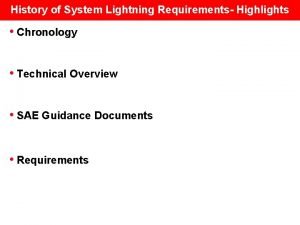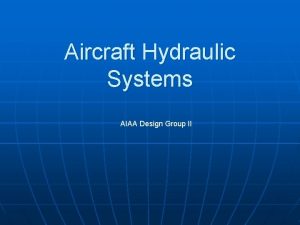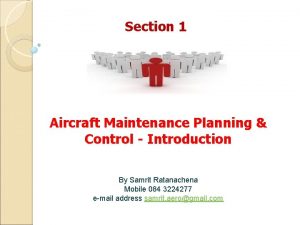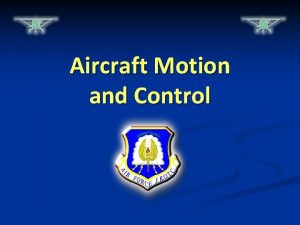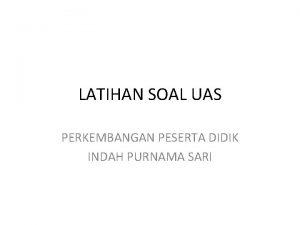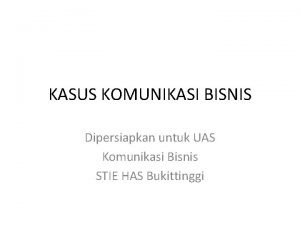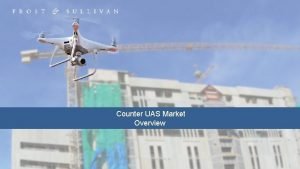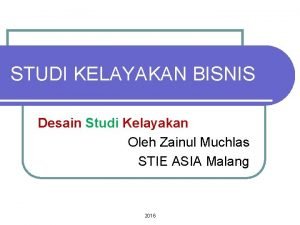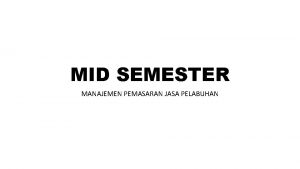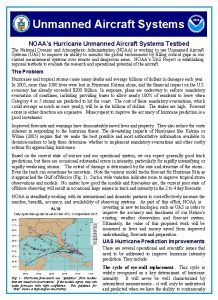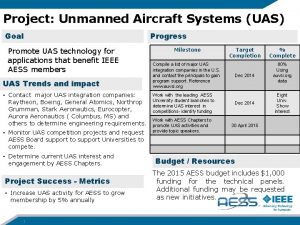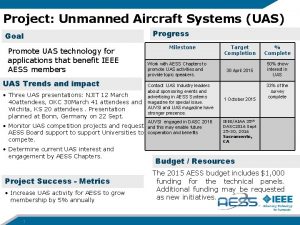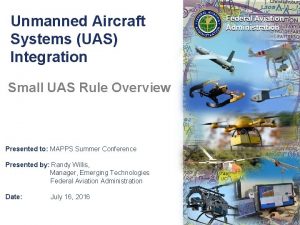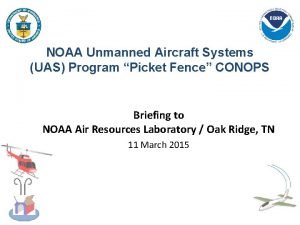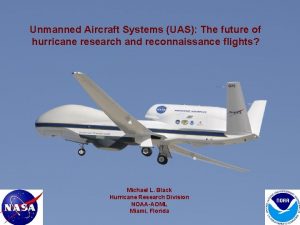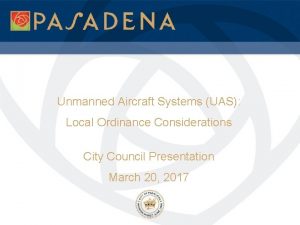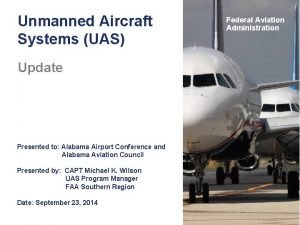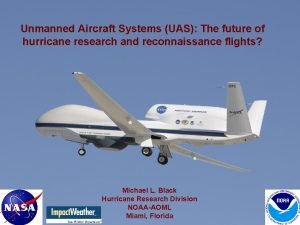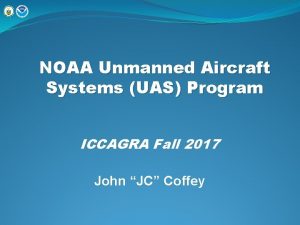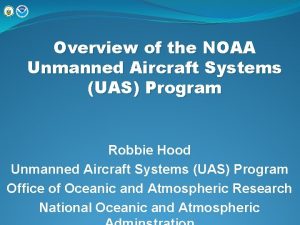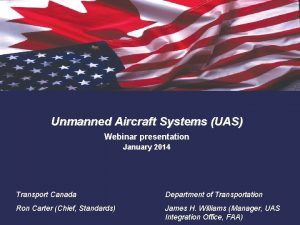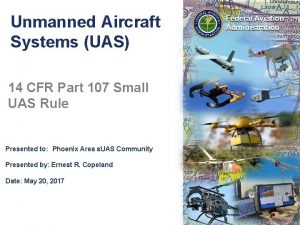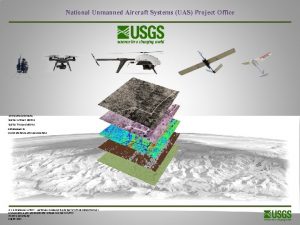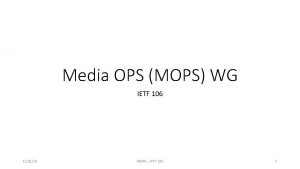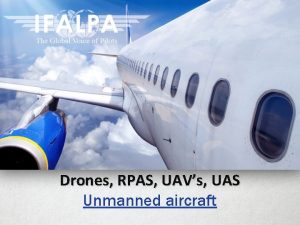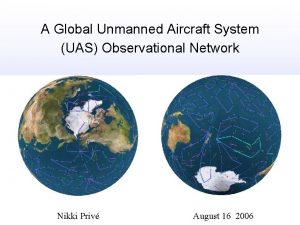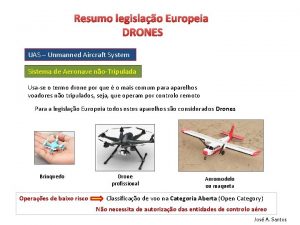RTCA MOPS for Unmanned Aircraft Systems UAS Control





















- Slides: 21

RTCA MOPS for Unmanned Aircraft Systems (UAS) Control and Non-Payload Communications (CNPC) C 2 LINK Presented to: By: Date: ICAO Don Nellis 8/29/2016 Federal Aviation Administration

RTCA UAS and Frequency Spectrum • CNPC/C 2 Link MOPS Phase 1 (Final approval pending) • CNPC/C 2 Link MOPS Phase 2 – due 2018 Satcom – due 2020 Terrestrial update/network • DAA MOPS Phase 1 (Due Winter 2016) • DAA MOPS Phase 2 (Future) Federal Aviation Administration 2

RTCA C 2 MOPS Phase 1 • Minimum Operating Performance Standards (MOPS) For Unmanned Aircraft Systems (UAS) Control and Non-Payload Communications (CNPC) (Terrestrial Only) Federal Aviation Administration 3

UAS Concept of Operations Phase 1 TOR focus Phase 1 MOPS also supports terrestrial networks (based on proprietary handover functionality) but does not address any industry standard handover capability, which will be addressed in Phase 2. Federal Aviation Administration 4

Intended Function of CNPC Link Systems The CNPC Link Systems addressed in the RTCA’s MOPS shall provide CNPC Link capabilities supporting the UAS information exchanges that allow the pilot to safely control, monitor, and manage the UA (often called the control and communication, C 2, function of the UAS). Depending on the intended operations, the systems and equipment shall also provide CNPC Link System capabilities supporting one or more of the following functions: • Air Traffic Control voice and data relay • Detect and avoid data exchange • Weather radar data exchange • Video data exchange The CNPC Link System shall not cause a hazard to other users of the National Airspace System. Federal Aviation Administration 5

CNPC Information Flows between Pilot and UA Federal Aviation Administration 6

Basic Internal and External Non-Payload Information Flows of a UAS Federal Aviation Administration 7

Security Considerations Higher layer security considerations, can either be implemented inside the CNPC Link System or within the remaining UAS System. CNPC Link System user plane and control plane security controls shall provide: • Mutual peer entity authentication between the Airborne Radio System and the Ground Radio System • Access control to authorize the Airborne Radio System access to the Ground Radio System • Data origin authentication of user and control plane traffic between the Airborne Radio System and the Ground Radio System • Data integrity for user and control plane traffic between the Airborne Radio System and the Ground Radio System • Confidentiality when sensitive user and control plane traffic is exchanged between the Airborne Radio System and Ground Radio System The security controls shall additionally be implemented with the following characteristics: • Using cryptographic algorithms with algorithm strength and key length sufficient to protect data in transit • Using formally validated cryptographic modules Federal Aviation Administration 8

Terrestrial Link Radio Systems • • • CNPC is an internal interface within the applicant’s system. It is not an external interface to ATS (Air Traffic Services) operational infrastructure (e. g. XPDR, ADS-B, CPDLC, Voice Comm) Interoperability between radios or systems is not a requirement, only electromagnetic compatibility. Under the current TOR (Terms of Reference) RCTA SC-228 covers the MOPS Validation Baseline as well as Manufacturer Specific radio specifications. • • Since the market is still maturing and different UAS will require different performance both MOPS Validation Baseline CNPC Link System and Manufacturer-Specific CNPC Link Systems are addressed in the MOPS Validation Baseline does not provide low level details to allow manufacturers to replicate an interoperable system but was primarily intended to validate the MOPS. Manufacturer-Specific designs are allowed and can use the flight test data from MOPS validation flight tests with deterministic scaling of performance (within prescribed limits) Initial implementation is expected to be stand- alone LOS (Line-of-Sight) systems to support limited geographic area. CNPC Link System Components Federal Aviation Administration 9

Specifications Frequency bands: C-Band: 5030 -5091 MHz L-Band: 1040 -1080 MHz 1104 -1150 MHz Power (max): C-Band: 10 W (Pavg: 18. 6 d. Bm/k. Hz) L-Band: 32 m. W (Pavg: -3. 4 d. Bm/k. Hz) limited to protect incumbent services Transmitter Bandwidth: • Maximum Bandwidth is 250 k. Hz • Also: In-Flight Emergency Video Channel of 500 k. Hz Two Takeoff and Landing Video Channel of 250 k. Hz The needed spectrum bandwidth will vary over time and location. Federal Aviation Administration 10

Specifications (cont. ) • MOPS Validation Baseline Transmitter Data Class Bandwidth: – – • Data Class 1 Data Class 2 Data Class 3 Data Class 4 62. 5 k. Hz(C 2 only) 125 k. Hz (C 2 + 1 enhancement) 187. 5 k. Hz (C 2 + 2 enhancements) 250 k. Hz (C 2+ 3 enhancements) Manufacture-Specific Transmitter Data Class Bandwidths are flexible within in the maximum 250 k. Hz allowed* – Inefficient use of spectrum will be discouraged through various mechanisms • The bandwidth is determined by the needed data for a specific flight phase/scenario (e. g. C 2 only, C 2 with A/G comm, C 2 with radar data, etc. ). *Note: the occupied bandwidth can vary, from one user to another and at one time to another (in 5 k. Hz increments). Federal Aviation Administration 11

Specifications (cont. ) CNPC TDD Frame Structure For the CNPC terrestrial MOPS we are using TDD instead of FDD to separate transmission from reception due to inefficient use of spectrum (diplexer cross over band) and the size and weight of the filters required in the aircraft. TDD FRAME 50 ma DOWNLINK SUBFRAME • TDD structure is based on TDD frames lasting 50 milliseconds each • Uplink TDD subframe is lasting 24. 3 milliseconds and the subsequent Downlink TDD subframe is lasting 25. 7 milliseconds • Uplink TDD subframe includes 1. 3 milliseconds of guard time to account for propagation delays and timing errors • Downlink TDD subframe includes 2. 7 milliseconds of guard time to account for propagation delays and timing errors Federal Aviation Administration 12

Emission Limits for CNPC Transmitters in Specific Bands Maximum CNPC Link System Power Spectral Density Allowed in Band a, b, c Band (MHz) Systems in Band Remarks CNPC Link System Ground Radios CNPC Link System Airborne Radios 0. 009– 0. 15 LORAN – 36 d. Bm/k. Hz Same as VDL Mode 2/3 MOPS 0. 15– 30 ADF, AM Broadcast & HF COM – 36 d. Bm/10 k. Hz Same as VDL Mode 2/3 MOPS 30– 108 Military VHF, FM & TV Broadcast – 36 d. Bm/100 k. Hz Same as VDL Mode 2/3 MOPS 108– 118 VHF NAV – 36 d. Bm/100 k. Hz Same as VDL Mode 2/3 MOPS if no on board VHF NAV – 64 d. Bm/100 k. Hz Protects on board VHF NAV with same level of protection VHF NAV is given by VDL Mode 2/3 MOPS 118– 137 VHF COM – 36 d. Bm/100 k. Hz Same protection as adjacent VHF NAV band if no on-board VHF COM Relay – 64 d. Bm/100 k. Hz Protects on board VHF COM Relay with same level of protection VHF COM is given by other MOPS 137– 960 Military UHF, Land Mobile & Marine UHF Radio, Cellular/ Wireless – 36 d. Bm/100 k. Hz Same as VDL Mode 2/3 MOPS Federal Aviation Administration 13

Emission Limits for CNPC Transmitters in Specific Bands (Cont. ) 960– 976 CNPC, TACAN, JTIDS +20 d. Bm/k. Hz, averaged over CNPC Link System transmitter channel 976– 980 UAT, ramp testers, JTIDS – 62. 2 d. Bm/MHz +20 d. Bm/k. Hz, averaged over CNPC Link System transmitter channel – 43. 2 d. Bm/MHz – 81 d. Bm/MHz 980– 1020– 1027 CNPC, DME, TACAN, JTIDS Protects co-located UAT. See Appendix G. Includes fundamental emissions in this optional CNPC Link System tuning range. CNPC Link System mask envelope applies. Frequency/distance/altitude management needed to coexist with DME and TACAN. +20 d. Bm/k. Hz, averaged over CNPC Link System transmitter channel – 62. 2 d. Bm/MHz – 37. 2 d. Bm/MHz Protects Y-Mode DME interrogators. See Appendix G. – 61. 2 d. Bm/MHz Protects DME beacons. See Appendix G. DME, TACAN – 81 d. Bm/MHz 1033– 1087 Protects UAT. See Appendix G for rationale. +20 d. Bm/k. Hz, averaged over CNPC Link System transmitter channel 1027– 1033 Includes fundamental emissions in CNPC Link System tuning range. CNPC Link System mask envelope applies. Frequency/distance/altitude management needed to coexist with TACAN. – 46. 2 d. Bm/MHz – 21. 2 d. Bm/MHz – 65 d. Bm in any 1 MHz Same as for 1020– 1027 MHz Protects co-located DME and TACAN interrogators. See Appendix G. Protects transponders and TCAS. See Appendix G. SSR, TCAS DME, TACAN, JTIDS Protects co-located transponders and TCAS. See Appendix G. Same as for 1020– 1027 MHz. Federal Aviation Administration 14

Emission Limits for CNPC Transmitters in Specific Bands (Cont. ) 1087– 1093 TCAS, – 56. 2 d. Bm/MHz Mode S ES – 47. 2 d. Bm/MHz – 65 d. Bm/MHz – 75 d. Bm in any 1 MHz Same as for 1020– 1027 MHz 1093– 1164 DME, TACAN, JTIDS Protects TCAS and Mode S ES on aircraft. Protects offboard SSR interrogators and Mode S ES. Protects co-located TCAS. Protects co-located Mode S ES. Same as for 1020– 1027 MHz. 1164– 1197. 6 GNSS, JTIDS – 84. 8 d. Bm in any 1 MHz – 86. 5 d. Bm in any 1 MHz CNPC Link System Ground Radio maximum is ITU-R Res. 417 AM(R)S EIRP density limit, minus assumed maximum CNPC Link System antenna gain. CNPC Link System Airborne Radio maximum is RTCA DO-235 B limit of – 146. 5 d. BW/MHz at GNSS receiver input, minus assumed 30 d. B isolation. 1197. 6– 1215 GNSS, JTIDS – 84. 8 d. Bm in any 1 MHz – 86. 4 d. Bm in any 1 MHz ITU-R Res. 417 AM(R)S EIRP density limits, minus assumed maximum L-band CNPC Link System antenna gain. 1215– 1300 GNSS, radars – 84. 8 d. Bm in any 1 MHz – 86. 4 d. Bm in any 1 MHz Same limits as those for 1197. 6– 1215 MHz band are assumed necessary here as well, to protect GPS L 2 and other GNSS signals in this band. 1559– 1605 GNSS (GPS L 1, Galileo E 1, GLONASS, Beidou) – 86. 5 d. Bm in any 1 MHz RTCA DO-235 B limit of – 146. 5 d. BW/MHz at GNSS receiver input, minus assumed 30 d. B isolation. Federal Aviation Administration 15

Emission Limits for CNPC Transmitters in Specific Bands (Cont. ) 5010– 5030– 5091– 5150 GNSS, Aero. MACS – 113 d. BW/MHz – 90 d. BW/MHz International Radio Regulations Footnote 5. 443 C AM(R)S EIRP density limit, minus assumed maximum C-band CNPC antenna gain. CNPC +20 d. Bm/k. Hz, averaged over CNPC transmitter channel +20 d. Bm/k. Hz, averaged over CNPC transmitter channel Includes fundamental emissions in CNPC Link System tuning range. CNPC Link System mask envelope applies. – 68 d. Bm/MHz – 44 d. Bm/MHz Protects Aero. MACS. – 79 d. Bm/MHz Protects co-located Aero. MACS Federal Aviation Administration 16

Operational Limitations for C Band • For a CNPC Link System radio C Band, when at or less than 10 NM from any takeoff and landing operation the Ground Stations: • • For a CNPC Link System radio C Band, the installed CNPC link system airborne power control must be used. For a CNPC Link System radio C Band, when at or less than 10 NM from any takeoff and landing operation the Airplanes: • • • Must only be used for takeoff and landing operations. Must not be located closer than 500 ft to the takeoff and landing or taxiway location. Must use high transmit power mode above 500 ft AGL. Must use low transmit power mode at or below 500 ft AGL. Must be operated above 3, 000 ft AGL if not taking off or landing. For a CNPC Link System radio C Band, when more than 10 NM from any takeoff and landing operation the Ground Stations must only be used for enroute operations. For a CNPC Link System radio C Band, when more than 10 NM from any takeoff and landing operation the Airplanes: • • • Must use high transmit power mode above 3, 000 ft AGL. Must use low transmit power mode at or below 3, 000 ft AGL. Must not be operated below 500 ft AGL. Operational limitations are required to protect Airborne and Ground receivers under adverse near-far conditions Federal Aviation Administration 17

Operational Limitations for L Band For a CNPC Link System radio L Band the Ground Stations: • Must not be operated within a certain standoff distance of a navigation receiver (distance measuring equipment (DME), tactical air navigation (TACAN), automatic dependent surveillance –broadcast (ADSB), Mode S, traffic collision avoidance system (TCAS), etc. ). • For operation at any geographic location, demonstrate that the CNPC link system can adequately protect the currently operational ground airborne equipment from interference. For a CNPC Link System radio L Band the Airplanes: • Must not be operated above 3, 000 ft above ground level (AGL). • Must not be operated within a certain standoff distance of a navigation receiver (DME, TACAN, ADS-B, Mode S, TCAS, etc. ). • For operation at any geographic location, demonstrate that the CNPC link system can adequately protect the currently operational ground airborne equipment from interference. Operational limitations are required to protect Airborne and Ground receivers under adverse near-far conditions and Incumbent Services Federal Aviation Administration 18

Future CNPC MOPS (Phase 2) • SATCOM • Ka • • 10. 95 -11. 2 GHz 11. 45 -11. 7 GHz 11. 7 -12. 2 GHz 14. 0 -14. 47 GHz • Ku • • 19. 7 -20. 2 GHz 29. 5 -30. 0 GHz • 1. 5 -1. 6 GHz AMS(R)S * • 5030 -5091 MHz ** • L • C • • Networked terrestrial C-Band Terrestrial – Update * Note: Looking for, but do not want to impose changes to current requirements. ** Note: A long term solution. No SAT currently exists Federal Aviation Administration 19

Detect-and-Avoid (DAA) MOPS • Frequency bands available for airborne Detect-and Avoid operations are (Phase 1): § § § § • 4. 2 -4. 4 GHz (radio altimeter band) 5. 15 -5. 25 GHz 5. 35 -5. 47 GHz (aircraft weather radars) 9. 3 -9. 5 GHz (aircraft weather radars) 13. 25 -13. 4 GHz (helicopter station keeping radars) 15. 4 -15. 7 GHz 24. 450 -24. 65 GHz 32. 30 – 33. 4 GHz Frequency bands for ground based Detect-and-Avoid operations are (Phase 2): § 1. 24 -1. 37 GHz § 2. 7 -2. 9 GHz § 9. 0 -9. 2 GHz For more info see: Report ITU-R M. 2204 Federal Aviation Administration 20

Federal Aviation Administration 21
 Rtca mops
Rtca mops Unmanned space probes
Unmanned space probes We are men my liege
We are men my liege Ote
Ote Pmops
Pmops Mops iława
Mops iława Feature point matching
Feature point matching Rtca do-227
Rtca do-227 Rtca do-178
Rtca do-178 Rtca do 160 section 22
Rtca do 160 section 22 Aircraft hydraulic systems
Aircraft hydraulic systems Aircraft maintenance planning
Aircraft maintenance planning Aircraft motion and control
Aircraft motion and control Vertical
Vertical Aircraft control surfaces and components
Aircraft control surfaces and components Contoh soal psikologi perkembangan remaja
Contoh soal psikologi perkembangan remaja Kasus komunikasi bisnis
Kasus komunikasi bisnis Helicobacter pylori e orticaria
Helicobacter pylori e orticaria Counter uas market
Counter uas market Desain studi kelayakan bisnis
Desain studi kelayakan bisnis Soal uas pemasaran global
Soal uas pemasaran global Mata kuliah perilaku organisasi
Mata kuliah perilaku organisasi
